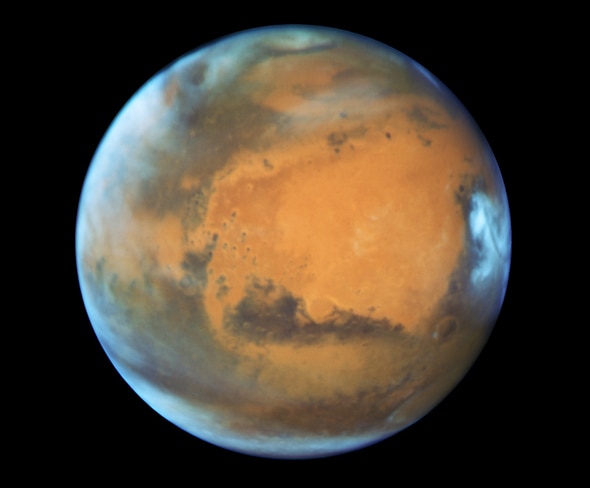Create a free profile to get unlimited access to exclusive videos, sweepstakes, and more!
Now’s a Good Time to Look Up as Mars Looks Back at You With Its Red,
Baleful Eye

The other day I was puttering around in the house a couple of hours after sunset and happened to glance out an open window. There, shining over the horizon in the east like a glowering eye, was an intensely bright red-orange “star.” I stopped for a moment, surprised, then realized what was going on: The star was a planet, specifically Mars, and it’s nearing opposition.
If you have a telescope, know someone who does, or live near an astronomy club (click here to find out!) or observatory, now’s the best time all year to see the Red Planet. It’s up all night and about as close as it can get to Earth. On May 30, it’ll be just a hair more than 75 million kilometers away, which as planets go is pretty close.
No, Mars won’t be as big as the Moon in the sky! Mars is only about 6,800 kilometers across, about half the width of Earth, and from 75 million kilometers away it looks pretty small. Still, it’ll be close enough that with a decent ‘scope you’ll see surface features. Maybe not as nice as that Hubble Space Telescope picture at the top of this post, but it’s pretty amazing to be able to see detail on the planet with your own eyes. If you get a chance to use a telescope over the next few weeks and observe Mars, take it!
So what’s going on? Mars and Earth both orbit the Sun like two cars going around a racetrack at different speeds; the Earth is on the inside track and moves a little faster. When Earth passes Mars on the inside curve, they’re as close together as they can be. When that happens, from Earth, we see Mars on the opposite side of the sky from the Sun—hence the term opposition. Because of that it rises when the Sun sets, and is up all night. It’s a twofer: Mars is as close as it gets, and it’s up at a convenient time to see it.
Things do get a bit complicated in the details. For example, Mars is on a fairly elliptical orbit that takes it as far as about 250 million kilometers from the Sun and as close as 207 million kilometers. That means some oppositions are better than others; the closest approach can range from 100 million to as little as 57 million kilometers from Earth. That means this one is fair to middlin’.
Because of its elliptical path, it also means opposition and perigee (the time it’s closest to Earth) don’t fall on the same day; opposition is May 22, over the weekend, but perigee is a week later.
Still and all, it’ll be bright and pretty for the next few weeks, so you don’t have to rush out and see it only on May 30! Any time through June and even July will be cool.
And if you want to impress people with your knowledge of Mars as you observe it at a star party, then may I suggest watching my episode of Crash Course Astronomy about the planet? Take notes if you want; there’s no test. The only goal is to understand the Universe around you better and appreciate it a little more.


























